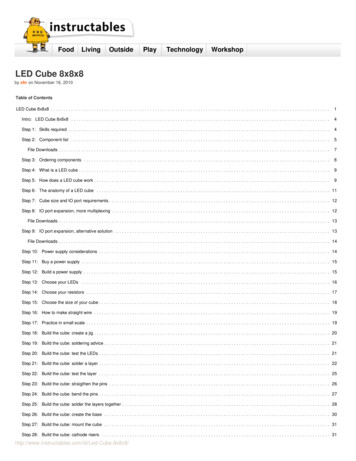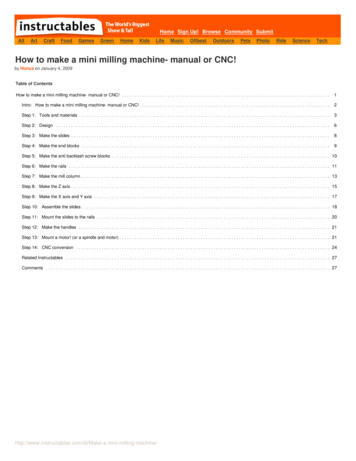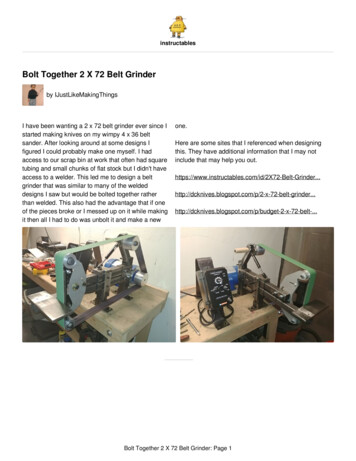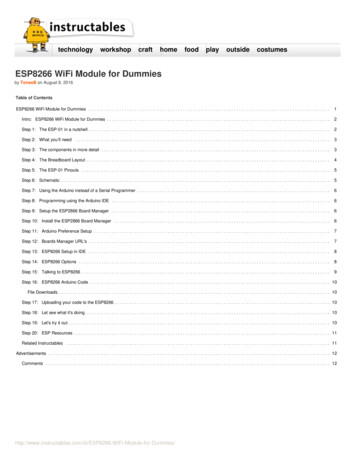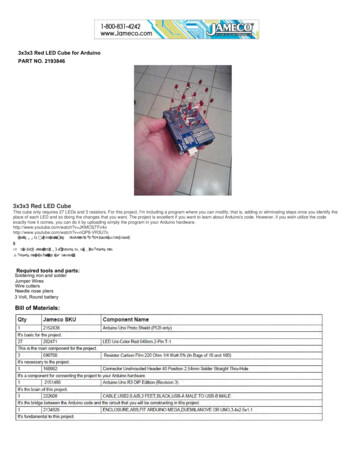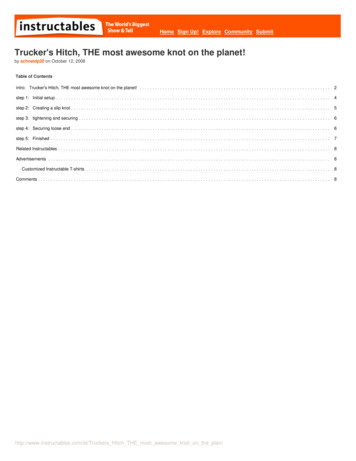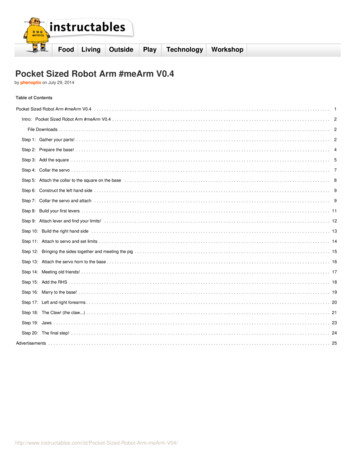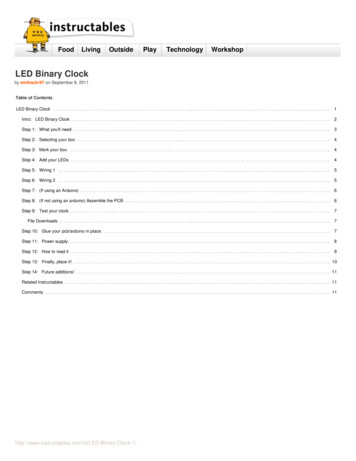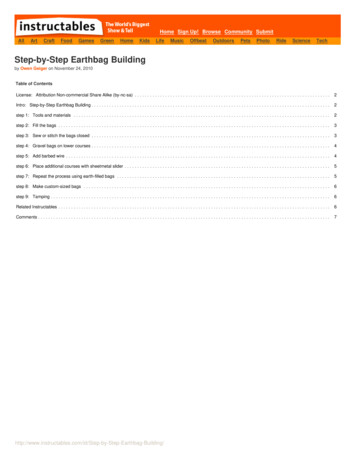
Transcription
Home Sign Up! Browse Community fbeatOutdoorsPetsPhotoRideScienceTechStep-by-Step Earthbag Buildingby Owen Geiger on November 24, 2010Table of ContentsLicense: Attribution Non-commercial Share Alike (by-nc-sa) . . . . . . . . . . . . . . . . . . . . . . . . . . . . . . . . . . . . . . . . . . . . . . . . . . . . . . . . . . . . . . . . . . . . . . . . . . . . .2Intro: Step-by-Step Earthbag Building . . . . . . . . . . . . . . . . . . . . . . . . . . . . . . . . . . . . . . . . . . . . . . . . . . . . . . . . . . . . . . . . . . . . . . . . . . . . . . . . . . . . . . . . . . . . . .2step 1: Tools and materials . . . . . . . . . . . . . . . . . . . . . . . . . . . . . . . . . . . . . . . . . . . . . . . . . . . . . . . . . . . . . . . . . . . . . . . . . . . . . . . . . . . . . . . . . . . . . . . . . . . . .2step 2: Fill the bags . . . . . . . . . . . . . . . . . . . . . . . . . . . . . . . . . . . . . . . . . . . . . . . . . . . . . . . . . . . . . . . . . . . . . . . . . . . . . . . . . . . . . . . . . . . . . . . . . . . . . . . . . . .3step 3: Sew or stitch the bags closed . . . . . . . . . . . . . . . . . . . . . . . . . . . . . . . . . . . . . . . . . . . . . . . . . . . . . . . . . . . . . . . . . . . . . . . . . . . . . . . . . . . . . . . . . . . . . .3step 4: Gravel bags on lower courses . . . . . . . . . . . . . . . . . . . . . . . . . . . . . . . . . . . . . . . . . . . . . . . . . . . . . . . . . . . . . . . . . . . . . . . . . . . . . . . . . . . . . . . . . . . . . .4step 5: Add barbed wire . . . . . . . . . . . . . . . . . . . . . . . . . . . . . . . . . . . . . . . . . . . . . . . . . . . . . . . . . . . . . . . . . . . . . . . . . . . . . . . . . . . . . . . . . . . . . . . . . . . . . . . .4step 6: Place additional courses with sheetmetal slider . . . . . . . . . . . . . . . . . . . . . . . . . . . . . . . . . . . . . . . . . . . . . . . . . . . . . . . . . . . . . . . . . . . . . . . . . . . . . . . . .5step 7: Repeat the process using earth-filled bags . . . . . . . . . . . . . . . . . . . . . . . . . . . . . . . . . . . . . . . . . . . . . . . . . . . . . . . . . . . . . . . . . . . . . . . . . . . . . . . . . . . .5step 8: Make custom-sized bags . . . . . . . . . . . . . . . . . . . . . . . . . . . . . . . . . . . . . . . . . . . . . . . . . . . . . . . . . . . . . . . . . . . . . . . . . . . . . . . . . . . . . . . . . . . . . . . . .6step 9: Tamping . . . . . . . . . . . . . . . . . . . . . . . . . . . . . . . . . . . . . . . . . . . . . . . . . . . . . . . . . . . . . . . . . . . . . . . . . . . . . . . . . . . . . . . . . . . . . . . . . . . . . . . . . . . . . .6Related Instructables . . . . . . . . . . . . . . . . . . . . . . . . . . . . . . . . . . . . . . . . . . . . . . . . . . . . . . . . . . . . . . . . . . . . . . . . . . . . . . . . . . . . . . . . . . . . . . . . . . . . . . . . . . .6Comments . . . . . . . . . . . . . . . . . . . . . . . . . . . . . . . . . . . . . . . . . . . . . . . . . . . . . . . . . . . . . . . . . . . . . . . . . . . . . . . . . . . . . . . . . . . . . . . . . . . . . . . . . . . . . . . . . . thbag-Building/
License: Attribution Non-commercial Share Alike (by-nc-sa)Intro: Step-by-Step Earthbag BuildingThis Instructable explains each main step of construction for building vertical earthbag walls. Videos on my Earthbag Natural Building YouTube channel demonstrate theprocess.For those who don’t know, earthbag building uses polypropylene rice bags or feed bags filled with soil or insulation that are stacked like masonry and tamped flat.Barbed wire between courses keeps bags from slipping and adds tensile strength. The final plastered walls look just like adobe structures. Thousands of people are nowbuilding with bags to create their dream homes, home offices, shops, resorts, rootcellars, storm cellars and survival shelters. Non-profit organizations are buildingschools, orphanages, emergency shelters and other structures.I got involved with earthbag building when the Indian Ocean tsunami hit Southeast Asia in December, 2004. As the director of Builders Without Borders at that time, Isearched all available affordable, sustainable building methods and decided building with bags was the most practical. They’re flood resistant (used for flood control),earthquake resistant (passed an ICBO shake table test), bullet and blast resistant (used for military bunkers), and now engineer and code approved plans are available.Just search for earthbag house plans on the Internet.Our websites at EarthbagBuilding.com and Earthbag Building Blog explain just about everything you need to know for free. And if you’re looking for house plans, myEarthbag House Plans site features over 110 sustainable plans that can be purchased through Dream Green Homes .The following instructions assume you have cleared and leveled the site, removed topsoil, positioned fill soil around the building site to minimize work, dug a trench tostable subsoil, put about 12” of gravel in the trench, and added corner guides and stringlines.Image Notes1. Vertical earthbag wallstep 1: Tools and materialsStep 1. Tools and materials (listed left to right): woven polypropylene bags (about 18” x 30”), bucket chute (4-gallon bucket with bottom cut off), 4 or 5 heavy duty 2gallon cement buckets, stringline, metal chisel and scrap steel for cutting barbed wire (or bolt cutters), hammer, sheetmetal slider (about 13” x 16”), 15 gauge galvanizedwire, knife, wire cutters, tape measure, 4-point barbed wire, corner guide, grub hoe or grape hoe, level, tampers, bundle 500 bags, shovel.Image Notes1. Earthbag tools and tep-Earthbag-Building/
step 2: Fill the bagsStep 2. Fill the bags: Use the same number of buckets for each bag. Fill bags approximately 90% full, leaving just enough to sew the bags closed. This technique ensureseach bag is filled to capacity to save bags, and each bag is the same size, which helps keep walls level.First Foundation BagImage Notes1. Filling earthbagsstep 3: Sew or stitch the bags closedStep 3. Sew or stitch the bags closed: fold the bag end over; use 15 gauge wire about 9” long with one end cut at a sharp angle; make one stitch on one side and bendthe end over; make a stitch in the center and pull the corner over; make a stitch in the other corner and pull the corner over; poke the remaining wire into the earthbag.This technique facilitates handling, prevents spills and enables bags to be filled to capacity.Stitching Bags ClosedImage Notes1. Stitch earthbags -Earthbag-Building/
step 4: Gravel bags on lower coursesStep 4. Lower courses: place gravel-filled bags (double-bagged for strength) working from the corners and openings to the center. Align bags to stringline; tamp the bagssolid and level after the course is complete. Always put tops of bags (the ends you’ve sewn closed) butted against other bags to prevent spillage. Maintain a runningbond as in masonry.Second Foundation BagImage Notes1. Gravel bags on lower coursesstep 5: Add barbed wireStep 5. Add barbed wire: use two strands of 4-point barbed wire in-between each course of bags; bricks or stones temporarily hold the barbed wire in place.Barbed WireImage Notes1. Barbed wire between courses of arthbag-Building/
step 6: Place additional courses with sheetmetal sliderStep 6. Use a sheetmetal slider to place additional courses so bags do not snag on the barbed wire: fill the bags on the slider; sew the end closed; tilt the bag intoposition and push it against the previous bag. After the bag is aligned, hold the end of the bag and jerk the slider out. Continue with gravel-filled bags until you are safelyabove the height where moisture can cause damage.First Bag Second CourseImage Notes1. Place bags using sheetmetal sliderstep 7: Repeat the process using earth-filled bagsStep 7. Repeat the process using earth-filled bags for upper courses, but with a few minor changes: turn bags inside out to avoid protruding corners; use lightlymoistened soil; lightly tamp the contents after each bucket of soil is added; pre-tamp each bag after it is aligned in position. This last step lengthens each bag to ensuregood overlap.First Earth Filled BagTamping First Earth Filled BagImage Notes1. Earth-filled tep-Earthbag-Building/
step 8: Make custom-sized bagsStep 8. Make custom-sized bags to fill odd-sized spaces: measure the opening; fill the bag to the approximate level; cut off excess bag material; fold each side of the endtoward the center and tuck under the bag; place the bag in the wall.step 9: TampingStep 9. Tamping: Tamp earthbags solid and level after each course is complete. Tamp the high points first. Once the wall is approximately level, evenly tamp the entirewall several times as you continually move the tamper so as not to create low spots.Tamping First Course of Earth Filled BagsRepeat the process for the remainder of the walls, adding doors and windows as you go. Check often to keep walls plumb and level.If you like this Instructable, please check out my other one that covers almost every detail for building a roundhouse: How to Build an Earthbag RoundhouseOwen Geiger is the former director of Builders Without Borders, a Mother Earth News Green Home Adviser, The Last Straw Journal Correspondent and the director ofthe Geiger Research Institute of Sustainable Building .Photos and videos by Got ChankamolImage Notes1. Tamping EarthbagsRelated InstructablesHow to Build anEarthbag Domeby Owen GeigerHow to Build anEarthbagRoundhouse byOwen GeigerDurable RaisedGarden Beds byOwen GeigerMake acousticpanels for yourHow to convertrecordinga closet into astudio or homemini wine cellartheater byby .com/id/Step-by-Step-Earthbag-Building/Build aConcrete BlockWall (video) bySakrete
Comments50 comments Add Commentthomas hemme8188 says:view all 62 commentsJan 31, 2011. 11:39 PM REPLYisn't there some sort of permit needed to build that sort of structure? always nice if there isnt.Owen Geiger says:Feb 1, 2011. 12:14 AM REPLYBuilding codes vary from country to country, state to state, even city to city. You'll have to talk to your local building officials.This is a huge subject of interest, because it has a major bearing on the cost of construction. You might want to join the discussion on our /24/counties-with-few-or-no-building-codes/hogey74 says:Jan 30, 2011. 5:12 PM REPLYJust a quick thankyou for this instructable! I love the super low embodied energy and simple construction techniques. Clearly optimized for people in lowSES circumstances but I can also see myself doing something like this on a secluded block of land one day as a holiday house. a great use of yourexperience for the benefit of others. Very admirable mate.Owen Geiger says:Jan 30, 2011. 8:34 PM REPLYThanks a lot. This really does help a lot of low income people. But there's also quite a few schools, resorts, orphanages and other structures being built,as well as luxury homes and vacation homes.rmgb says:Jan 30, 2011. 6:25 PM REPLYDoes anyone know if these are hurricane-resistant? I know they're bullet- and earthquake-resistant, but unfortunately that doesn't always make them able towithstand hurricanes.Owen Geiger says:Jan 30, 2011. 8:26 PM REPLYYes, we believe they are. However, we're lacking complete testing to validate this. There was a wind tunnel test scheduled for December, but I haven'theard what happened. I imagine we'll hear from the engineers doing the study shortly. All the news like this is updated daily on our Earthbag BuildingBlog. http://earthbagbuilding.wordpress.comThe next best thing is using the design developed by Precision Structural Engineering at Structure1.com. Any engineer can quickly see this is a verystrong design that would be hurricane resistant with a good roof design. It would also meet code. So if you're serious, please email them.neddup98 says:Jan 28, 2011. 10:14 AM REPLYLooks good - economical, fast, and I guess a decent insulation value when the soil has dried out. However, the integrity of the wall depends on the plasticbags holding up. While you note the need to protect the empty bags from sunlight in your comments, I couldn't see anything in the instructions to indicatethat ultraviolet protection like the parging like you did in your Round House or sheathing is essential if the wall is going to last. I filled some feed bags withfirewood offcuts two years ago and forgot about them outside. When I tried to pick them up last fall, the bags completely disintegrated. I know most builderswill want to cover the wall anyway for aesthetic reasons but it wouldn't hurt to make it clear that this is not merely an option. Otherwise, a good idea clearlydescribed. I think I have accumulated enough fed bags that I couldn't bear to throw away to build at least half a shed.Owen Geiger says:Jan 28, 2011. 5:22 PM REPLYYes, this is an important point that must be emphasized. But I didn't want to repeat too much stuff from the first Instructable.Soil actually has very low insulation value. It's effective in moderate and hot climates because the walls are thick and high mass. It's called the thermalflywheel effect.In cold climates you can build insulated earthbag houses. That's a future Instructable.drewgrey says:Jan 28, 2011. 4:56 PM REPLYInteresting, Reminds me of a history teacher I had in high school who grew up in a sod house .seabeepirate says:Jan 27, 2011. 11:36 PM REPLYThis is awesome! I was really into the straw bale buildings for a while but this seems like it will stand up to a lot more.Owen Geiger says:Jan 28, 2011. 12:10 AM REPLYNo building system is perfect for all situations. You have to consider many variables to determine what is best for you. Strawbale has lots of advantages.It's super fast. We stacked the bales for a 1,000 sq. ft. Habitat for Humanity home in less than one day. First we built a wood frame. Then we stacked thebales on edge against the wall. But bales are more susceptible to moisture damage than tamped earthbags. Again, use what makes most sense for -by-Step-Earthbag-Building/
rimar2000 says:Nov 24, 2010. 6:15 PM REPLYAwesome! I like this eco-friendly way of building. I subscribed your Youtube channel, there are interesting things. I never had the opportunity to build ahouse, but I would like to experience one of these non-traditional techniques. I really like the domes too, whether or not Buckminster Fuller's.Owen Geiger says:Nov 24, 2010. 7:10 PM REPLYThe YouTube videos turned out to be very popular. 1-3 people sign up almost every day. I have 8 more videos planned on CEBs, earthbag benches, etc.If this site becomes popular, I'll add more Instructables.Jayefuu says:Jan 23, 2011. 11:02 AM REPLYPlease do! You might find this instructable useful to help you fill your bags ndbags-the-Easy-way-with-Sandbag-Tubes/Owen Geiger says:Jan 23, 2011. 4:18 PM REPLYIt's easier filling bags in place on the wall. That way you're only handling one small bucket of soil at a time. Full bags weigh around 100 pounds,so would be too difficult to carry around.nerys says:Jan 27, 2011. 8:19 PM REPLYby yourself? yes. but if you have help thats what a lawntractor and a small trailer are for :-)Owen Geiger says:Jan 27, 2011. 9:09 PM REPLYThat's great if you can afford it. Most people doing this do everything by hand. I like three person crews: one person filling buckets, onecarrying buckets, one filling and placing bags.nerys says:Jan 27, 2011. 10:38 PM REPLYahh its not hard to get a good running lawn tractor for 50 to 75 and REALLY NICE ones for 100 to 150.I just buy them in the fall when no one wants them and just want them gone (don't even THINK of buying them in the spring 250 isthe lowest which is why I have 4 extra's :-)the trailer I got for 12. well free then I bent the rim straight and bought the 12 inner tube it needed from home depot.Owen Geiger says:Jan 27, 2011. 11:35 PM REPLYYour idea makes sense at that price. Construction is hard work and having the right tools can make things so much easier.rimar2000 says:Nov 25, 2010. 3:26 AM REPLYOwen, Instructables is VERY POPULAR. People around the world has it as daily read. In example, I live in Argentina and use Google Translator toread and write English. You will meet here many followers, they will profit your teachings.Owen Geiger says:Nov 25, 2010. 5:25 AM REPLYOh, I agree. I've been reading Instructables for a couple years or so. They're a great resource and I'm glad to be published here.When I said "If this site becomes popular." I meant this particular Instructable on earthbag building.twighahn says:Jan 27, 2011. 3:38 PM REPLYi wonder how well this wouold work for an underground homeOwen Geiger says:Jan 27, 2011. 4:56 PM REPLYWe just talked about this. Read the other comments and search our blog. It works great, that's why I have quite a few earth bermed, earth sheltered andunderground earthbag designs. See Earthbag House Plans.twighahn says:Jan 27, 2011. 5:56 PM REPLYwhere is your blog?Owen Geiger says:Jan 27, 2011. 8:57 PM REPLYEarthbag Building Blog: http://earthbagbuilding.wordpress.com/Currently 433 posts on every aspect of building with bags, and 1,377 comments. This is where we put all the breaking news, new projects, arthbag-Building/
twighahn says:Jan 27, 2011. 5:47 PM REPLYsomething to add to my plans im a drafter but retired the only house i plan to draw is my dream house which is undergroundDAMO NZ says:Jan 27, 2011. 5:02 PM REPLYAny chance of posting a pic of finished project? or is this as far as you got?Owen Geiger says:Jan 27, 2011. 5:28 PM REPLYThis is a demonstration wall used for training purposes. There are thousands of earthbag houses, schools, resorts, etc. around the world. Our earthbagwebsites document the best projects. Here's just one link: htm. Many more are on our blog.I plan to publish our roundhouse as an Instructable soon, since most people don't document the entire process.extrordinary1 says:Jan 27, 2011. 1:12 PM REPLYGreat instructable. I worked construction 16 years before my heart gave out.I never got to build my dream earth contact home, and I was considering something like this, using recycled materials as much as possible to keep the costminimal.I never got to buy any land to build on, and now, I know my heart can not withstand a project like this. I'm due to return for more heart surgery within the nextthree months to replace my defibrillator/pacemaker battery, and do an oblation to stop what they call PVC's which I experience daily.Funny your last name is Geiger, I have a Geiger ready mix concrete license plate on my car. I strongly considered using the huge blocks they make withwash-out concrete to build a home with. On top of a strong concrete slab with very strong footings, and add underground braces to prevent quake damagefrom causing the walls to cave in.You have done a great job with this instructable. After my heart went bad, I went into electronic engineering school, but was forced to quit half way through,as my heart couldn't take the stresses involved. I turned to designing alternative energy projects, especially wind power, that will produce far more poweroutputs than normal wind generators with counter rotation.It is also nice to see you are a builder without borders. I greatly respect and admire those who do such things. I tried very hard to get all those people whoclaim they are feeding the 3rd world countries kids. building schools. only to be rejected time and time again, even from so called evangelical people doingthe same. I found one local source, they have a massive property to maintain, massive building, many employee's driving cars that are very expensive. Themoney isn't reaching the cause.I also researched many other things, such as stripping humidity to keep our well full, distill it, use a solar furnace when possible to assist in the distillation ofwater. Keep up the great work, and God bless you for it.Owen Geiger says:Jan 27, 2011. 4:55 PM REPLYYou should post your ideas on Instructables. Sounds like some really projects. Take care of yourself.raygris says:Jan 27, 2011. 12:11 PM REPLYWhen I was last at Cal Earth (Late 90s) They had roles of the uncut fabric tubes that are cut and sewn to make the bags. The end where just folded underinstead of sewn shut after filling. Is there an advantage to using cut and sewn bags instead of the tubes?They also had made hoppers on adjustable stilts and rollers that stratled the wall. A skip loader filled the hopper that rolled along filling the tube. Is there afaster process now?Owen Geiger says:Jan 27, 2011. 4:52 PM REPLYMost people don't have tractors or skip loaders, so we usually focus on simple, low cost techniques. For instance, most people can get bags or recycledbags easier than tubes. Filling bags to maximum capacity and sewing them closed creates larger bags with greater overlap between courses, whichcreates stronger walls and saves bags. So sewing is extra work, but its practical for certain situations.Here's a discussion about mass production earthbag: ass-production-earthbag-101/There are industrial machines now that fill tubes incredibly fast. They're used to fill tubes for erosion control barriers, etc., but they're not practical forbuilding houses.rclane48 says:Jan 27, 2011. 11:20 AM REPLYAnother source of bags is from folks that use wood pellets to heat their home or business. A ton of 40 pound bags yields 50 bags. Depending on the size ofthe house, the length if the heating season, or how the stove is used, one house may use anywhere from 1 to 10 tons per season.Owen Geiger says:Jan 27, 2011. 4:46 PM REPLYThat's a new idea I hadn't heard, thanks. Poly bags are so common in some areas that you can find recycled bags bundled for sale real cheap at feedstores, etc.raygris says:Jan 27, 2011. 9:51 AM REPLYNice to see someone is 'building' on the work of Nader Khalili, the late Persian architect. Having been in several serious earthquakes, I was most impressedwith this building systems ability to exceed California's most extreme earthquake zone standards.I saw a 1996 video interview with the head of the Hisperia building dept. (Tom Harp?) When National Geographic asked him if the system had been tested,he answered, "Kind of." When it had exceeded 200% of the zone 4 standard, they quit the test because the test fixture was tep-Earthbag-Building/
Owen Geiger says:Jan 27, 2011. 4:43 PM REPLYYes, and a more recent shake table test at the University of Nevada showed earthbags passed the levels experienced by the Northridge, CA quake. Justsearch our blog for details. This is a huge concern in earthquake regions. Now there's about a dozen earthbag projects under development in Haiti.Precision Structural Engineering will stamp plans for seismic and non-seismic areas so anyone can get a building permit. So slowly this building methodis moving into mainstream.incorrigible packrat says:Jan 27, 2011. 8:57 AM REPLYWow, a decent use for barbed wire (unlike using it for animal containment).Nice corner there.Anyone looking for bags should contact a farmer (if there's any left in the area). Most farms will have plenty of empty poly feed bags lying around. (I kindamiss the old burlap sacks, they were so jute!)Owen Geiger says:Jan 27, 2011. 4:27 PM REPLYWe encourage the use of recycled bags since so many farmers have them in abundance. Just make sure they've been stored out of sunlight and are thesame size. Make a test earthbag to make sure the bags are strong.kevinpatrick says:Jan 27, 2011. 1:59 PM REPLY"they were so jute!"Hey-O! :)Suarve says:Jan 27, 2011. 7:10 AM REPLYHi Owen, I'm considering building a garage sized workshop on piece of land outside my house in the UK, I was looking for a solution which is well insulatedand build-wise as close to carbon neutral as I can get it, and your designs look perfect.I had a quick look at your blog site but most of the guidance seems to be for hotter climes (or at least places which spend a substantial part of the year veryhot). Do you have any information on how the design stands up in more temperate regions such as Western Europe? I'm thinking specifically of the barbedwire rusting and losing integrity as happens with roofing nails in the UK, which typically last 70-80 years but which are not hammered into a damp material tostart with.I'm also curious as to any advice you have on how best to let the bags dry out (which I assume is a requirement) in such an environment.Could you please point me to any areas on your blogsite which could be useful?Thank loads - your system looks excellent.Owen Geiger says:Jan 27, 2011. 4:18 PM REPLYThis topic is discussed in some detail. The search features on our sites are very good (Wordpress on the blog, Google at EarthbagBuilding.com). Searchfor cold climate and insulated earthbag.No worries about the barbed wire inside a protected wall. Even out in the elements, barbed wire can last over 100 years. (Again, we have a blog post onthis. Search barbed wire on the blog.)Mesh bags dry out faster than poly bags. Some call this hyperadobe. So search for hyperadobe or mesh bags on our blog.pdc4770 says:Jan 27, 2011. 8:54 AM REPLYFor the UK, try the traditional Welsh building technique 'clom'It's a mixture of earth, straw and aggregate. It's cheap, lasts up to a couple of hundred years and has fabulous inslating qualities. The challenge you'llhave is getting the right consistency.Have a look okshop/?book ls/WIG-WEN-FACH%2C LLANERCHAERON/Owen Geiger says:Jan 27, 2011. 4:39 PM REPLYSounds good. I'll look into it. There are lots of similar mixtures. Straw usually isn't needed because the bags and barbed wire hold the walls together.That eliminates one step of building -- no need for straw, no cutting and mixing. Although it might contribute slightly to the R-value.Suarve says:Jan 27, 2011. 10:14 AM REPLYThanks - I'll check this outwillrandship says:Jan 27, 2011. 3:47 PM REPLYReminds me of minecraft :PGreat idea.TALLJ29 says:Jan 23, 2011. 4:28 PM REPLYIts a great project, but my concern is that these polypropylene bags are affected by sunlight (1600 hours or so). They will weaken over time That can be fixedby eithera. Building your structure undergroundb. Covering the bags with sheeting or other ep-Earthbag-Building/
On another note where would you recommend getting the bags from.Also, i'm curious about how you would do the roof.This is pretty cool.Owen Geiger says:Jan 26, 2011. 5:46 AM REPLYWhere to buy bags: Your best bet is to use Google to search for a supplier near you. That should reduce shipping costs. We also list a few companies onour Resources page (scroll down): www.earthbagbuilding.com/resources.htmOwen Geiger says:Jan 23, 2011. 5:35 PM REPLYBags need UV protection for projects that take more than a few weeks. You can pay extra for UV protected bags with a special coating. Or you can spraycheap or recycled latex paint on the earthbag walls if necessary (or even brush it on).You can build almost any roof imaginable -- trusses, pole roof, TJIs, etc.Broom says:Jan 24, 2011. 12:24 PM REPLYBrilliant! And simple! Like the rest of this instructable.Ryonin says:Jan 23, 2011. 9:55 PM REPLYAnd of course, as is stated in the instructable, the finished walls would be plastered. A coat can go on as soon as the contents of the bags havedried; long before significant damage is done. This would probably be faster with a stucco sprayer.view all 62 ep-Earthbag-Building/
bag-Building/ step 2: Fill the bags Step 2. Fill the bags: U



